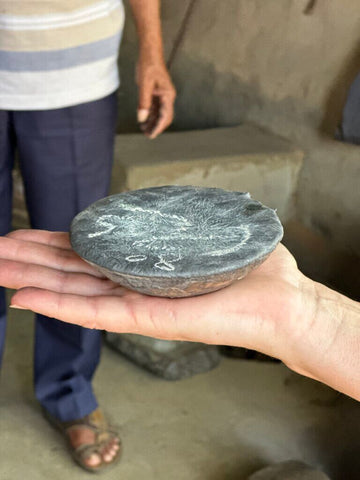
The most important facts in brief
- The Peter Hess® Therapy Singing Bowls is made from pure metals in an elaborate and complex process that involves many different steps.
- Fair working conditions and ethical standards have been important to Peter Hess from the very beginning and still are today.
- Every single bowl is made by hand and undergoes intensive quality controls on its way from India to Germany.
- Only those Singing Bowls that meet the high quality standards receive the Peter Hess® Therapy seal.
- Production and quality control are the same for all types of singing bowls - from the head bowl to the cymbal bowl.
- The Peter Hess® Therapy Singing Bowls are further divided into the Premium quality for professional sound work and the Classic quality for private use.
- The therapy singing bowls can be coated with a protective permanent coating, which is recommended for certain areas of application.
What materials are used in the manufacture of a Peter Hess® Therapy Singing Bowl ?
Only high-quality and, above all, pure metals are used in the production of Peter Hess® Therapy Singing Bowls . The use of high-quality metals naturally also means higher manufacturing costs, but it guarantees the exceptional and optimal sound and vibration quality.
The main components of the bronze alloy used to make singing bowls are copper and tin. Other pure metals are added in small quantities. To pay tribute to the traditional blacksmith's art of earlier times, we add a piece of an old Singing Bowl to each alloy melt.
Good to know
Incidentally, such alloys have been used since the Bronze Age, i.e. for thousands of years - for church bells, for example. They are known for their strength, hardness and corrosion resistance.
Overview of the traditional production process of Peter Hess® Therapy Singing Bowls

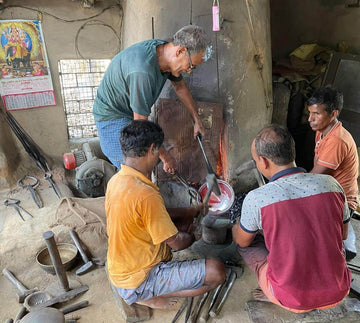
The production process of Peter Hess® Therapy Singing Bowls is a complex and time-consuming process that involves numerous different steps. With this greatly simplified description of the production process, we would like to give you a brief insight.
1. production of the bronze alloy
In the blast furnace, the various metals are melted into a high-quality bronze alloy. The highest possible tin content is essential for the high sound quality. At the same time, the tin makes the forging process more difficult. Accordingly, it takes specialist knowledge and a great deal of experience to determine exactly the right proportion of this expensive metal.
2. casting the singing bowl blanks
In the next step, blanks are cast from the molten metal in a special, lenticular mold. Once the alloy has solidified, they are removed from the molds and tested for their suitability for further processing.
3. forging the Singing Bowl
A Singing Bowl is then forged, i.e. shaped, from the freshly cast blank using traditional forging tools. Depending on the type of singing bowl, at least 25 forging sessions with thousands of hammer blows are required until the final shape is achieved. Four to six experienced blacksmiths work on a bowl at the same time. A blacksmith uses long tongs to ensure that the red-hot metal is continuously turned during the forging process so that the Singing Bowl can be forged evenly. He also keeps an eye on the forge fire so that the cooling alloy can be reheated if necessary. This can be necessary up to 100 times during the entire process for larger Singing Bowls . The other blacksmiths hammer the red-hot metal disc into a uniformly shaped bowl in perfect rhythm with countless hammer blows. Once the Singing Bowl has reached its final shape, it is quenched in a cold liquid.
4. fine tuning of the Singing Bowl
The next step is to fine-tune the Singing Bowl with special hammers. Various forging techniques are used to precisely shape the form, sound and vibration.
5. cleaning the Singing Bowl
Oxides or slag can remain on the surface of the Singing Bowl from the melting and forging process, for example. The bowl is first roughly cleaned using simple mechanical means and then scraped out by hand. This procedure further contributes to perfecting the sound and vibration behavior.
6. polishing the Singing Bowl
We use a special ash mixture for the final polish of the Singing Bowl . Rice straw and mustard oil are burnt and mixed into a creamy paste. This mixture is used to carefully polish the Singing Bowl for several minutes to remove any remaining impurities. This final step also gives the Singing Bowl its typical shiny surface.
The manufacturing process is completed when the Singing Bowl is polished. Some therapy singing bowls are additionally sealed in Germany with a permanent coating, which provides an additional protective barrier. This is recommended for certain work areas.
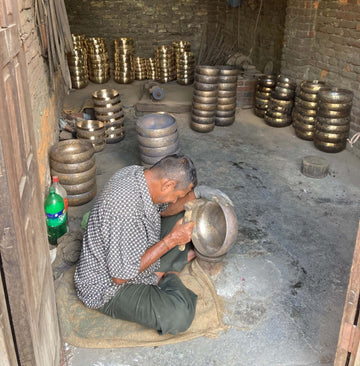
The different types of singing bowls from Peter Hess® Therapy Singing Bowls Production
The manufacturing process described is the same for all types of singing bowl, whether universal, cymbal, head or heart bowl. The different types of singing bowl have a characteristic shape and size as well as a typical sound, frequency and vibration behavior.
The production of the different types of singing bowls always takes place in a family group. This not only allows us to ensure that the quality of our Singing Bowls remains at the highest level, but also provides an income for an entire family.
Good to know
Only this "standardization" of the singing bowl types made it possible to communicate the Peter Hess® sound massage and sound methods safely and uniformly and to research their effects. Today we know quite precisely which Singing Bowl appeals particularly well to which parts of the body. Nevertheless, every Singing Bowl is and remains unique, just as every sound experience is always unique. A certain range of sound and vibration within the types is therefore absolutely desirable in order to meet people's individual needs and preferences.
The Peter Hess® singing bowl types at a glance
You can find out exactly how the individual types differ and which areas of the body they are used on in our overview of Singing Bowls for sound therapy.
Quality controls on the way to Peter Hess® Therapy Singing Bowl
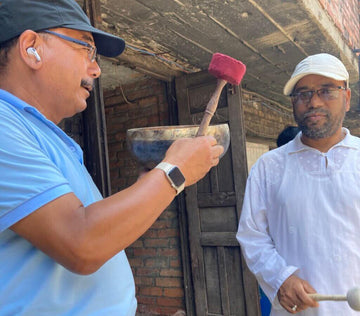
Before a Singing Bowl receives a quality seal, it undergoes extremely intensive quality controls in India. Only if it passes these is it shipped to Germany, where it is also subjected to a special quality control for suitability for bodywork. Here it is divided into the quality levels "Peter Hess® Therapy Singing Bowl Premium" and "Peter Hess® Therapy Singing Bowl Classic".
Quality controls in India
All our Singing Bowls undergo an initial inspection in India. In this way, we ensure that the sound, frequency and vibration behavior as well as the appearance meet the high quality standards of a Peter Hess® Therapy Singing Bowl . An experienced metal engineer, who was instrumental in setting up the production, is responsible for this task.
The Singing Bowls who pass this check are then taken from small towns in India, for example, to Delhi. Once there, they undergo another thorough inspection in specially equipped rooms. Electrical measuring equipment is also used here for the first time: an electrical engineer and an experienced employee use various measuring techniques to check the quality of the shells. Only those Singing Bowls that successfully pass this rigorous testing process are packaged for transportation to Germany.
Note
If our team detects any defects when checking the high-quality Singing Bowls , this is immediately reported back to production. In this way, possible sources of error can be quickly identified and improvements made immediately. For this reason, there may occasionally be waiting times for certain types of singing bowls.
In addition, the high quality of Peter Hess® Singing Bowls has led to increased demand worldwide. In order to meet this demand, new craftsmen have to be trained. It takes a lot of time and experience before they are able to manufacture Singing Bowls to our quality standards.
In the next step, the Singing Bowls are securely packed and usually loaded with other sound materials into a container and onto a ship in Mumbai. Once they arrive in Germany, a truck is already waiting to transport the valuable cargo the last leg of the journey to the Hess Sound warehouse.
Listening and quality classification of Singing Bowls in the Hess Sound warehouse
It is always something special when the new goods arrive in our warehouse from India. On these days, almost the entire warehouse team is busy unpacking, inspecting and pre-sorting the Singing Bowls for the upcoming quality inspection.
Our requirements for a therapy singing bowl are extremely high: only the best Singing Bowls receive the "Peter Hess® Therapy" seal at the end of the intensive quality assurance process. Singing Bowls with this seal are characterized not only by their special appearance, but above all by their outstanding sound and vibration characteristics. Depending on whether a Singing Bowl fulfills the specified criteria down to the last detail or only almost, it receives the "Peter Hess® Therapy Premium" or "Peter Hess® Therapy Classic" seal in the quality classification.
Only employees who have been trained for many years are able to assess Singing Bowls on the basis of the numerous criteria and then classify it.
Classification into the Premium and Classic quality levels
The two quality levels of Peter Hess® Therapy Singing Bowls (Premium and Classic) are derived from the fact that the Singing Bowls exhibit certain tonal or visual differences after the production process during quality testing, which cannot be avoided in traditional handcrafted production. Both qualities come from the same production, have undergone the same forging process and are of exceptional quality. All types of singing bowls are available in both quality levels.
Quality levels of Peter Hess® Therapy Singing Bowls
- Peter Hess® Therapy Singing Bowl Premium
- Peter Hess® Therapy Singing Bowl Classic
What distinguishes a Peter Hess® Therapy Singing Bowl Premium?
The Peter Hess® Therapy Singing Bowl Premium is the jewel among the Singing Bowls. Similar to a diamond, where an inconspicuous stone becomes a high-carat gem, it is also a long way until different metals become a Singing Bowl of this quality.
The Peter Hess® Premium Singing Bowl is characterized by an extraordinary vibration behavior and sound pattern. Thanks to many years of research and close links to practice, we can now say exactly which properties a Singing Bowl must have in order to have a special effect on body and mind. Only if a Singing Bowl meets all the sound and visual criteria of our quality process is it suitable for use in professional sound work, as taught at the Peter Hess® Institute and the Peter Hess® Academies worldwide. Such a bowl is awarded our highest seal "Peter Hess® Therapy Premium". It is primarily used in professional sound work - be it in sound massage, sound education or sound therapy. However, it can of course also be used in the private sphere.
Qualities of Peter Hess® Therapy Singing Bowl Premium at a glance
- Excellent vibration and frequency behavior and sound image
- Particularly well-balanced effect on body and mind
- Numerous studies and scientific research have proven positive and health-boosting effects
- Available in all types of singing bowls
Recommended areas of application for Peter Hess® Therapy Singing Bowl Premium
Professional sound work, for example:
- Sound massages
- Wellness treatments
- Sound pedagogical support and advice
- Sound coaching
- Sound therapy interventions
- Sound and fantasy journeys
- Sound baths
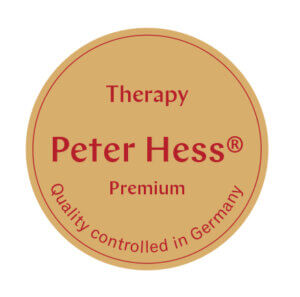
What characterizes a Peter Hess® Therapy Singing Bowl Classic?
With its excellent sound and equally good vibration quality, the Peter Hess® Therapy Singing Bowl Classic is very well suited for personal use, for use in kindergartens or schools as well as for private use in sound massage. Our classicSinging Bowls must also meet high quality standards and therefore have almost the same vibration and frequency behavior as a premiumSinging Bowl, but not quite.
The dimensions and shape correspond to the Premium-Singing Bowl, but the Classic-Singing Bowls can also vary slightly in shape, color and weight, as each one is individually handcrafted. Like the Premium-Singing Bowls , the Classic-Singing Bowls are also available for different areas of the body, i.e. in the types of singing bowls mentioned.
Qualities of Peter Hess® Therapy Singing Bowl Classic at a glance
- Very good vibration and frequency behavior as well as sound image
- Particularly well-balanced effect on body and mind
- Available in all types of singing bowls
Recommended areas of application for Peter Hess® Therapy Singing Bowl Classic
Primarily in the private sector, for example:
- Self-application
- Sound massages in the private sphere
- Sound meditations or rituals
- Accompaniment of e.g. yoga practice
- Supplementary use in education or therapy
- Sound and fantasy journeys
- Sound baths
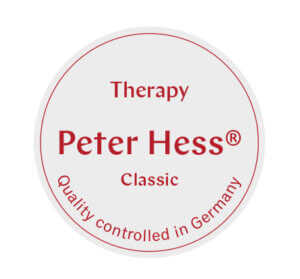
Why are some Peter Hess® Therapy Singing Bowls available with a permanent coating and what are the advantages?
We know from experience that oxidation can occasionally occur on the surface of Singing Bowl . This can be caused by high humidity, salt content in the air, salt or chlorine in the water or close contact with the skin and, for example, sweat, water or disinfectants. The oxidation process is completely natural and can occur again and again. For this reason, we recommend regular cleaning of the Singing Bowl, especially with frequent use, so that the stains do not "burn in". Singing Bowls The surfaces used in hospitals, nursing homes or in the wellness and spa sector can be particularly affected by this.
For this reason, we have found a way to apply a high-quality permanent coating to the Singing Bowls in Germany. This involves applying a wafer-thin, transparent protective film only around three thousandths of a millimeter thick to the Singing Bowl . This protects the surface from reacting with the environment and ensures that the bowl retains its shine permanently without the need for polishing. This makes the bowl particularly easy to clean. A simple wipe with a soft cloth is enough to clean the Singing Bowl . The transparent tarnish protection has no effect on the sound of the therapy singing bowl. The vibrational properties of the Singing Bowl therefore remain completely unaffected by this additional treatment.
Advantages of Peter Hess® Therapy Singing Bowls with permanent coating at a glance
- Uncomplicated application in combination with oils, water or disinfectants
- Very easy to clean
- Easy to clean
- Can be easily disinfected
- Odorless
- No repolishing necessary
- Permanently glossy surface of the Singing Bowl
In these cases, we recommend the permanent coating
- When using Singing Bowls directly on the skin
- If the Singing Bowl needs to be disinfected frequently
- If the bowl often comes into contact with water, especially salt or chlorinated water
- Generally for use in nursing homes, hospitals and spas
You can also find an overview of the diverse areas of application of Peter Hess® Therapy Singing Bowls in our article on the use of singing bowls.






